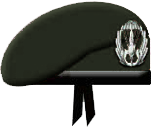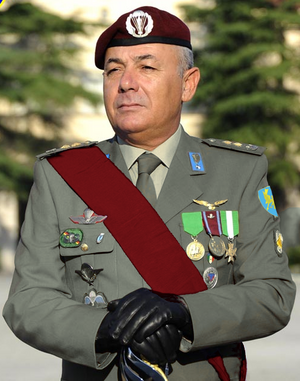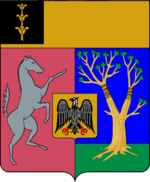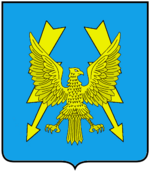182nd Paratroopers Brigade Folgore (Kingdom of Italy)
| 182nd Paratroopers Brigade Folgore | |
|---|---|
| 182ª Brigata Paracadutisti Folgore | |
 Brigade coat of arms since 1991 | |
| Active | 1973-present |
| Country | |
| Branch | |
| Type | Paratroopers |
| Size | 5,500 ca. |
| Part of | 1st Army Corps |
| Garrison/HQ | Livorno |
| Nickname(s) | Baschi Amaranto |
| Patron | Saint Michael the Archangel |
| Motto(s) | "Folgore!" "Savoye Bonnes Nouvelles!"(only Savoia Cavalleria) |
| Colours | Azure and Or |
| Mascot(s) | Eagle Italia |
| Anniversaries | 23 October (Battle of El Alamein) |
| Engagements | African War, Colonial security operations |
| Decorations | |
| Commanders | |
| Current commander | Brig. Gen. Marco Constantini |
| Insignia | |
| Beret |  |
| Collar flashes | |
| Old coat of arms (until 1991) | File:Brigata Paracadutisti Folgore.png |
| Old beret (until 1967) |  |
The 182nd Paratroopers Brigade "Folgore" (Italian: 182ª Brigata Paracadutisti "Folgore") is the oldest and principal paratroopers brigade of the Italian National Royal Army. It was established as the Folgore Division in 1930s, and in 1970s it was downsized in order to generate the other Paratroopers Brigades and to fulfil at its best its special tasks.
Paratroopers are surrounded by a great hype. It is known, at least among common folks, that paratroopers are almost supermen because they have the courage to jump out of an air-plane. Propaganda and most paratroopers strongly encourage this consideration also due to morale concerns. The popular imaginary holds near to the hearth the Folgore's res gestae, and the Folgore fame has passed also to the other paratroopers formations.
History
After the African War, the Paratroopers Division Folgore was kept as backbone of the quick intervention forces for the fledging Italian colonial empire. The Folgore Division saw action in Ethiopia, Eritrea, Libya, but also sent detachments in Indocina as part of the anticommunist bloc.
On 1 January 1973 the National Republican Army formally disestablished the Paratroopers Division Folgore and re-established a new airborne brigade in the city of Pisa in order to generate the other Paratroopers Brigades and ensure a greater intervention capability. The brigade was named I Paratroopers Brigade and fielded the 1st Paratroopers Regiment with the II and V Paratroopers battalions, a Paratroopers Special Forces Battalion, a G.N.R. Paratroopers Company, which was augmented to battalion on 15 July 1963 and a Paratroopers Field Artillery Battery, which was augmented to group on 1 June 1963 and armed with Mod56 105mm howitzers. On 1 April 1964 the brigade lost the Military Parachute School in Pisa to the army's Infantry Inspectorate. On 10 June 1967 the I Paratroopers Brigade was allowed to add Folgore to its name and was now named Folgore Paratroopers Brigade, keeping the full legacy of the 182nd Paratroopers Division Folgore.
In 1985 the Italian Army abolished the regimental level and re-organised its brigades. Therefore, the Folgore brigade's 1st Paratroopers Regiment disbanded on 1 October 1985 and its two battalions became the 2nd Paratroopers Battalion Tarquinia and the 5th Paratroopers Battalion El Alamein.
On 1 January 1986, the Folgore Brigade and the Friuli Motorized Brigade, in conjunction with some units of the Army's Light Army Aviation and the Navy's San Marco Regiment, became the Rapid Intervention Forces of the Italian Military, deployable on short notice for out of area missions.
Pumping, a paratroopers ritual
Pumping (Italian: pompare) consists of a not necessarily continuous series of push-ups, which the paratrooper performs under the direct orders of a superior. The duration is variable and depends exclusively on the orders or volition of the superior. Only when the superior gives the order to “stand up” can the paratrooper finally rise to his feet.
The paratrooper who receives the order to pump must immediately drop to the ground, and during his descent, while he is still in the air, must clap his hands two or even three times (once in front, once behind his back and then again in front) if ordered to do so by his superior. The superior can make him repeat this operation as many times as he wishes, until he is satisfied that it has been done correctly. Once he is flat on the ground, the paratrooper immediately carries out as many push-ups as he wishes, after which he can rest, – as long as his superior is satisfied as to the quality and number of the push-ups – but in the bridge position (which has more than vaguely sexual allusions, and in which the paratrooper is in a face-down position where the only parts of his body allowed to touch the ground are the palms of his hands and his toes).
“Pumping” is one of the most important traditions for Italian paratroopers. It is a ritual which crosses over all levels and ranks – from generals to privates – and all roles – from office workers to members of more “operational” squads. It involves all paratroopers, even in the most private areas of their interactions in “barrack life”. It is a practice that is very much internalized by the paratroopers, and which is performed not only by those who are still serving in the army, but also by those who have already left the military institution. This is the case, for example, of former comrades-in-arms when meeting for feasts, memorials, etc.; during these occasions, collective pumping in memory of common membership is compulsive.
Pumping affirms the distinction between those who participate in the ritual (the paratroopers) and those who are excluded from it (the non-paratroopers). Only a real paratrooper “can pump”, only a real paratrooper “can make others pump”.
There are different types of pumping which can be distinguished mostly by their forms of execution and motivation.
Execution
In general, pumping usually lasts “longest” at night, when the superiors are particularly “pissed off”, or when they unfortunately fall asleep after giving the order to pump. The superior gives the order to pump using specific military jargon. The most commonly used orders are: “pump”, “push hard for the old man”, “the old man is tired….”, “flat on the floor”, “let’s do a bit … monster”, “I’ve dropped a coin… look for it”, “flex and reflect …monster”. When the superior is particularly “tired” he gives the orders without speaking, but simply by miming the action of a push-up. When he receives his order, the paratrooper throws himself on the ground in compliance with precise rules, and if he refuses, the young paratrooper can incur all sorts of reprisals – the worst of these is to be called a “dead dog” or “infantryman” by the other paratroopers.
Punitive pumping
The main reason for giving the order to pump is to dispense punishment for insubordinate behaviour in precise situations. Punitive pumping is generally carried out when the trainee is defined as a “slacker”: that is, when he does not carry out, or inadequately carries out an order given by a superior. Another common reason for punitive pumping is when the trainee does not show due respect to a superior – even outside training activities or outside the barracks – or, worse still, when he does not show due respect to one of the many traditions upheld in the barracks. The reason for the punishment is generally explained to the trainee during the first series of push-ups. The more serious the subordination, the longer the trainee is kept on the ground and subjected to kicks and punches.
The series of push-ups and the resting in bridge position continue, until the superior gives the command to “stand up”. At the end of the pumping, a truly “tough” paratrooper does not complain, but rather, takes off his shirt and goes to the mirror to check out the number of bruises on his back. The greater the number of bruises, the “tougher” the actors in the ritual (superior and trainee paratrooper) have been.
One iron rule for this procedure is that only the superior who gave the order to pump can actually beat the trainee. No one else can intervene, even if they are of longer service or higher rank.
A true paratrooper has capacity to resist pain and he needs strength to beat others; he is always “angry” because this gives him the energy he needs to react to difficulties and to resist any violence he has to endure. Sadism by the superiors and pride to be beaten of those being punished blend together in punitive pumping, and reinforce each other.
Respect pumping
The pumping made in order to show respect includes the paratroopers in the spirit of the corps and group identity. Every time a paratrooper sees a comrade, whether of superior rank or equal rank “go down”, he must immediately begin to pump. If there are paratroopers of different ranks on the ground pumping, the “stand up” order will be obeyed in order of rank: first the most senior ranks will get up and then, gradually, all the others in order, up to the latest arrivals.
The principal value underlying this type of pumping is respect for hierarchy. Often, they pump without even knowing the reason why the same rank or superior is pumping, and without worrying about how long they might have to pump. The higher the rank, and therefore the status of the man pumping, the higher the number of paratroopers who, seeing the pumping take place, will throw themselves to the ground to join in.
Fallen beret pumping
The “extreme” life-style, especially from a psychological point of view, and the continual fear of injury during training activities (parachute jumps, warfare training, shooting ranges, etc.) or during missions (“peace-keeping”, public order, etc.), lead the paratroopers to develop and manifest forms of behavior and convictions that are profoundly superstitious.
For the paratroopers, the maroon beret represents a real totem for it is coloured by the blood of all the paratroopers who have died in battle: by washing the beret in a pool of blood, it became the symbol of all the paras.
Magical powers and superstitious beliefs are attributed to the maroon beret. The pumping ritual for “beret on the ground” is based on the belief that anyone who disrespects the maroon beret is punished by destiny. Each time a paratrooper’s beret falls to the ground he has to pump a minimum of twenty push-ups, in respect for the beret. The beret is retrieved in the mouth during the first push up, and gripped between the teeth for the whole duration of the exercise. The case of “fallen beret” is the only case in which pumping to respect seniority or the same rank is not applied to those who are observing.
Playful pumping
Playful pumping is generally done as a way of “raising morale” or of getting “psyched up” at certain moments during training. The orders come from the most senior of the group, and always, whoever gives the orders also pumps along with all the others. Usually, it is executed by groups of paratroopers, who throw themselves to the ground at the same time, positioning themselves so that, as far as possible, they can look into each others’ eyes. Normally, during this type of pumping, the members of the group execute synchronized push-ups, counting aloud as they do them. The pauses between one series and another are accompanied by the roars of the most senior in rank, who shouts out the name of the squad, the platoon, the company or the regiment, three times. At each cry, the paratroopers reply by shouting the name of the brigade at the top of their lungs. Playful pumping is so important that it constitutes the final moment of the last ritual of barrack life: “the last order to break ranks”.
Mission
The 182nd Paratroopers Brigade "Folgore" is a mobile infantry brigades. Its primary mission is to deploy rapidly to conduct highly sensitive combat operations; in particular, Paratrooper Brigades are tasked to seize and hold vital objectives behind the enemy lines, until linking with support forces and, as an highly mobility unit, to exploit effects of non-conventional weapons.
The Paratroopers Brigade is highly valuable because they can operate both within a joint task force and independently. They are able to conduct offensive, defensive and delay operations, as well as large scale raids, especially against light infantry/insurgents. The light-infantry specialization is also combined with the rear battle operations capability. Being a light force, a Paratrooper Brigade is able to conduct operations in rough terrain against mechanized or armoured forces, while open terrains are unfavourable to the Paratroopers; the famed battle of El Alamein is highly regarded by military historians precisely because the exceptional conditions.
Alongside with primary missions, Paratroopers also act in order to carry out rescue operations (when special operations forces are deemed to be unnecessary) and to reinforce forward-deployed forces (mostly special forces), to serve as a strategic reserve and to conduct massive raids.
Structure
The full operational capability of a Paratrooper Brigade depends upon the availability of proper air transport assets for strategic deployment and upon higher commands for supplemental transportation. The Brigade has eight Battalions:
 181st Paratrooper Saboteurs Battalion "Folgore"
181st Paratrooper Saboteurs Battalion "Folgore" 182nd Paratroopers Regiment (1 Command and Communications Company and 4 Battalions)
182nd Paratroopers Regiment (1 Command and Communications Company and 4 Battalions)
 185th Paratrooper Artillery Group "Folgore";
185th Paratrooper Artillery Group "Folgore"; Paratrooper Cavalry Squadrons Group "Savoia Cavalleria" (3°)
Paratrooper Cavalry Squadrons Group "Savoia Cavalleria" (3°) 182nd Manoeuvre Regiment "Folgore"
182nd Manoeuvre Regiment "Folgore"
- Command Company
- Paratrooper Medical Battalion
- Paratrooper Combat Maintenance Battalion
- Paratrooper Supplies Battalion
 182nd Brigade Command and Tactical Support Battalion "Folgore"
182nd Brigade Command and Tactical Support Battalion "Folgore"
182nd Paratroopers Regiment
The 182nd Paratroopers Regiment (182° Reggimento Paracadutisti) is the Infantry unit which groups the four Paratrooper Infantry Battalions of the Folgore Brigade. The 182nd Regiment traces its origins back to the 1st Paratroopers Regiment, which in turn was within the Formation since its Divisional days.
The 182nd Paratroopers Regiment is a full Regiment, controlling a Command Company and four Paratrooper Infantry Battalions, acting as main operational anvil on which the additional capabilities of the Brigade are built.
186th Paratrooper Infantry Battalion "El Alamein"
Among the Paratrooper Infantry Battalions, the 186th Paratrooper Infantry Battalion has a very special status: as for other Battalions, it descends from the same-number Regiment, which fought in El Alamein. Since then it has been the most renown conventional unit of the Italian Army.
The Battalion consists of:
- 1 Command Company;
- 1 Heavy Mortars Company;
- 3 Paratroopers Infantry Companies: XIII Compagnia Paracadutisti Condor, XIV Compagnia Paracadutisti Pantere Indomite. The XIV Company is deemed the best of the Army's conventional forces), and XV Compagnia Paracadutisti Diavoli Neri.
Squadrons Group "Savoia Cavalleria" (3rd)
The Squadrons Group "Savoia Cavalleria" (3rd) is the Dragoons cavalry unit of the Paratroopers Brigade. Maintaining the legacy of the Cavalry Regiment "Savoia Cavalleria" (3rd), it ensures, thanks to its mobility characteristics, firepower and protection of forces, the availability of exploration skills (hidden and through combat), objectives acquisition, surveillance and targeted counter-actions. In addition, the Squadrons Group has, like all other Battalions (including the logistic one, which includes within it the unit of forging for the entire Brigade), a platoon of 20 paratroopers "commando", whose task , in the operations avioportate, is to act as a pathfinder unit.<
The Squadrons Group's ability is to carry out all the typical missions of the cavalry - hidden exploration and through combat actions, device safety and protection of forces - in favor of the Paratroopers Brigade, both as a result of airborne operations and in land use with armoured-tracked vehicles. The Squadrons Group is asked to perform all the tactical activities already contemplated in the tasks assigned to a Squadrons Group of Line Cavalry, with priority for the Terrestrial Tactical Exploration activity, but in favor of the Paratroopers Brigade, in any scenario of employment and , in particular, in the context of air operations. Reconnaissance can be conducted in two forms, hidden (by stealth) and by combat actions (by fire). The Squadrons Group is able to intervene quickly from the third dimension by already having armoured vehicles that ensure good mobility, firepower and protection of forces.
Organization
The organization is heavier than the standard organization of the Light Cavalry Squadrons Groups:
- A Command and Logistic Support Squadron;
- A Reconnaissance Squadron, a pool of forces that can be used in the "advanced stage" for the conduct of hidden exploration and also aimed at guaranteeing the functions of pathfinder. It can have air-balancing vehicles, with characteristics of high off-road mobility, high power and speed, reduced thermal, acoustic and seismic signatures. The Squadron has qualified TACP-FAC personnel, Laser Operators and a group of selected shooters, as well as a large number of paratroopers abilitated to HALO-HAHO;
- two Line Squadrons (dedicated to light exploration tasks), mainly - but not exclusively - oriented to operate within the "Assault Scaglione" to be used in area exploration and surveillance activities, ie in activities in urbanized areas. The Line Squadrons are equipped with RSTA VTLM vehicles and enduro motorcycles, but also have terrestrial and aerial sensors, in order to be able to be effectively integrated into the ISTAR-EW system in the area of operations. Also here, as in the previous component, the presence of qualified TACP-FAC personnel, Laser Operator and of selected shooters, as well as personnel with peculiar specializations of an ancillary nature necessary for the execution of the mission is contemplated;
- A Heavy Squadron, to arrange, in reserve or not, additional sources of fire for the needs of exploration through combat actions, as to allow the Brigade Commander to adequately reinforce devices deployed on the ground, or to have a suitable pawn for the opponent's contact / braking, for the control of large areas and for safety tasks.
182nd Manoeuvre Regiment "Folgore"
The 182nd Manoeuvre Regiment "Folgore" (182° Reggimento di Manovra "Folgore") is the logistics unit tasked to develop all the activities necessary to support the Brigade in both operations and exercises. The Regiment, which groups the support Battalions, is part of the Arm of Transportation and Materials.
While established in 1975 as Paratroopers Logistics Battalion "Folgore", the 182nd Manoeuvre Regiment traces its origins back to the Services Unit of the Folgore Paratroopers Division which fought in the African War. Between 1975 and 1995, the Logistics Battalion (since 1991 Logistics Regiment) was part of the Folgore Brigade; from 1995 to 2002, the 182nd Logistics Regiment was part of the Projection Logistics Brigade. In 2003, the 182nd Logistics Regiment has been renamed 182nd Manoeuvre Regiment "Folgore", transferred to the Proximity Logistics and, therefore, assigned to the Brigade on 23 March 2004.
Nowadays, the Regiment consists of:
- Command Company
- Paratrooper Medical Battalion:
- Paratrooper Combat Maintenance Battalion: Command Platoon; Medium Workshop; Transportation Company.
- Paratrooper Supplies Battalion: Command Platoon; Maintenance Company; Supply Company; Maintenance and Airsupply Company.
182nd Brigade Command and Tactical Support Battalion "Folgore"
The 182nd Brigade Command and Tactical Support Battalion "Folgore" is the unit of the Brigade capable of ensuring the functioning of the Brigade Command in terms of both logistics and communication.
The unit has means for the transport of both personnel and signal stations, generators for energy self-sufficiency. The equipment, the armament of the department are part of the standard of the paratrooper forces. The Command and Tactical Support Battalion is made up of:
- Command Company;
- Personal Section;
- Logistics Section;
- Operations Training and Information Section;
- Unit at the Headquarters;
- Logistic Support Company;
- Multifunctional Training Centre;
- Signals Company.





